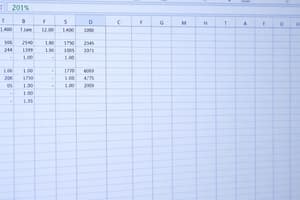Podcast
Questions and Answers
Which company developed Excel?
Which company developed Excel?
- Microsoft (correct)
- IBM
- Apple
What is the primary use of Excel?
What is the primary use of Excel?
- Email Communication
- Video Editing
- Web Browsing
- Organizing, analyzing, and storing data (correct)
What is the primary file in Excel called?
What is the primary file in Excel called?
- Document
- Page
- Worksheet
- Workbook (correct)
What is the intersection of a row and a column in a worksheet called?
What is the intersection of a row and a column in a worksheet called?
In Excel, formulas always start with which symbol?
In Excel, formulas always start with which symbol?
Which function adds up the values in a range of cells?
Which function adds up the values in a range of cells?
Which of the following is NOT a chart type available in Excel:
Which of the following is NOT a chart type available in Excel:
What is the purpose of Excel macros?
What is the purpose of Excel macros?
Which file format is the default for Excel workbooks?
Which file format is the default for Excel workbooks?
Which keyboard shortcut is used to save a file in Excel?
Which keyboard shortcut is used to save a file in Excel?
Flashcards
What is Excel?
What is Excel?
Software for organizing, analyzing, and storing data in tables, performing calculations, creating charts, and automating tasks.
What is a Workbook?
What is a Workbook?
The primary Excel file, which can contain one or more worksheets.
What is a Cell?
What is a Cell?
The intersection of a row and a column in a worksheet. (e.g., A1, B2).
What is AutoFill?
What is AutoFill?
Signup and view all the flashcards
What are Functions?
What are Functions?
Signup and view all the flashcards
What is the SUM function?
What is the SUM function?
Signup and view all the flashcards
What are Pivot Tables?
What are Pivot Tables?
Signup and view all the flashcards
What is a Macro?
What is a Macro?
Signup and view all the flashcards
What is an Absolute Reference?
What is an Absolute Reference?
Signup and view all the flashcards
What are Data Tables?
What are Data Tables?
Signup and view all the flashcards
Study Notes
- Excel is a spreadsheet software developed by Microsoft.
Core Functionality
- Excel is used for organizing, analyzing, and storing data in tabular form.
- Users can perform calculations, create charts, and automate tasks through formulas and macros.
Key Components
- Workbook: The primary file in Excel, containing one or more worksheets.
- Worksheet: A grid composed of rows and columns where data is entered.
- Cell: The intersection of a row and a column, identified by a cell reference (e.g., A1, B2).
- Ribbon: The toolbar at the top of the Excel window, providing access to various commands and features.
- Formula Bar: Located below the ribbon, it displays the content of the active cell and allows for formula input and editing.
Data Entry and Manipulation
- Data Types: Excel supports numbers, text, dates, and boolean values.
- Data is directly entered into cells, with Excel often recognizing the data type automatically.
- AutoFill: Automatically fills cells with a series of data based on a recognized pattern.
- Copy and Paste: Data can be copied within or between worksheets/workbooks.
- Sorting: Data can be sorted alphabetically or numerically using one or more columns.
- Filtering: Data can be filtered to display rows meeting specific criteria only.
Formulas and Functions
- Formulas: Expressions that perform calculations on data in cells and always begin with an equals sign (=).
- Cell References: Used in formulas to refer to other cells (e.g., =A1+B1).
- Operators: Symbols (+, -, *, /, ^) are used in formulas for arithmetic operations.
- Functions: Predefined formulas that perform specific calculations (e.g., SUM, AVERAGE, COUNT).
- Common Functions:
- SUM: Adds values in a range of cells (=SUM(A1:A10)).
- AVERAGE: Calculates the average of values in a range of cells (=AVERAGE(A1:A10)).
- COUNT: Counts the number of cells in a range that contain numbers (=COUNT(A1:A10)).
- COUNTA: Counts the number of non-empty cells in a range (=COUNTA(A1:A10)).
- IF: Performs a logical test, returning one value if true and another if false (=IF(A1>0,"Positive","Negative")).
- VLOOKUP: Searches for a value in the first column of a table and returns a value from a specified column in the same row (=VLOOKUP(A1,B1:C10,2,FALSE)).
- HLOOKUP: Searches for a value in the first row of a table and returns a value from a specified row in the same column.
- Named Ranges: Assigning a name to a cell or range of cells, this makes formulas more readable and easier to understand.
Charts and Graphs
- Excel offers various chart types, including bar charts, line charts, pie charts, and scatter plots.
- Charts can be created from selected data ranges, visually representing the data.
- Charts can be customized with titles, labels, and formatting options to enhance clarity and appearance.
Data Analysis Tools
- Pivot Tables: Interactive tables summarizing and analyzing large datasets.
- Pivot Chart: A dynamic chart based on pivot table data.
- Goal Seek: Finds the input value needed to achieve a target result.
- Scenario Manager: Defines and compares different sets of input values to see their impact.
- Solver: An add-in finding optimal solutions to optimization problems by adjusting variables subject to constraints.
Automation with Macros
- Macros: Recorded action sequences that can be replayed to automate repetitive tasks.
- VBA (Visual Basic for Applications): The programming language used to create and edit macros in Excel.
- Recording Macros: Excel can record user actions and generate VBA code for automation.
- Editing Macros: The VBA editor allows users to modify and customize recorded macros.
- Security: Macros can pose a security risk if they contain malicious code and Excel provides security settings to manage macro execution.
Conditional Formatting
- Formatting is applied to cells based on specific criteria (e.g., highlighting cells with values greater than 100).
- Rules can be based on cell values, formulas, or other specified conditions.
- Color Scales and Icon Sets: Visual aids representing data ranges with gradients or icons.
Data Validation
- Rules define the type of data that can be entered into a cell (e.g., restricting input to a specific range of numbers or a list of items).
- Input Messages: Displays a message when a cell is selected, with instructions for data entry.
- Error Alerts: Displays an error message when invalid data is entered.
Collaboration and Sharing
- Excel workbooks can be shared for collaborative editing.
- Co-authoring: Multiple users can work on the same workbook at the same time.
- Track Changes: A feature that records changes made by different users, allowing for review and acceptance/rejection of modifications.
- Comments: Comments can be added to cells to provide explanations or feedback
File Formats
- .xlsx: The default file format for Excel workbooks (Office Open XML spreadsheet).
- .xls: An older file format for Excel workbooks (Binary file format).
- .csv: A comma-separated values file format for storing tabular data.
- .xlsm: Excel workbook with macro-enabled.
Printing
- Page Layout View: Allows adjustment of page settings, margins, and headers/footers before printing.
- Print Area: Specifies the portion of the worksheet to be printed.
- Scaling: Adjusts the printed content size to fit on a specific number of pages.
Keyboard Shortcuts
- Ctrl+C: Copy
- Ctrl+X: Cut
- Ctrl+V: Paste
- Ctrl+Z: Undo
- Ctrl+Y: Redo
- Ctrl+S: Save
- Ctrl+P: Print
- Ctrl+A: Select All
- Ctrl+F: Find
- Ctrl+H: Replace
- Ctrl+N: New Workbook
- Ctrl+O: Open Workbook
- Ctrl+W: Close Workbook
- Ctrl+Tab: Switch between open workbooks
- F2: Edit Cell
- F4: Cycle through absolute and relative references in a formula
- F5: Go To
- Ctrl+Space: Select entire column
- Shift+Space: Select entire row
Absolute and Relative References
- Relative Reference: A cell reference that changes when a formula is copied to another cell.
- Absolute Reference: A cell reference that remains constant when a formula is copied to another cell (indicated by $ signs, e.g., $A$1).
- Mixed Reference: A cell reference with a combination of relative and absolute references (e.g., $A1 or A$1).
Error Values
- #DIV/0!: Occurs when a formula tries to divide by zero.
- #NAME?: Occurs when Excel does not recognize a name used in a formula.
- #N/A: Occurs when a value is not available in a formula or function.
- #REF!: Occurs when a cell reference in a formula is no longer valid.
- #VALUE!: Occurs when a formula contains an argument of the wrong type.
- #NULL!: Occurs when a formula contains an invalid intersection of ranges
- ######: Occurs when a column is not wide enough to display the entire value in a cell.
Data Tables
- Used to perform "what-if" analysis with one or two variables.
- One-Variable Data Table: Analyzes how changes in a single input variable affect a formula.
- Two-Variable Data Table: Analyzes how changes in two input variables affect a formula.
Power Query
- Data Transformation: A data connection technology that enables discovery, connection, combination, and refinement of data from various sources.
- Data Sources: Connect to various data sources, including web pages, databases, excel files, etc.
- Steps recorder: Records the transformations performed on the data.
- Power Query Editor: Edit transformations applied to a data source.
Power Pivot
- Data Modeling: A data modeling tool that lets you create relationships between tables, calculate columns, and create custom measures.
- Large Datasets: Used to analyze large datasets that exceed Excel's limitations.
- DAX language: Uses the DAX formula language.
Studying That Suits You
Use AI to generate personalized quizzes and flashcards to suit your learning preferences.




